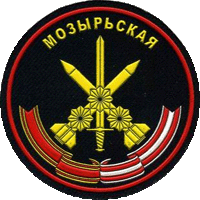
The 19th Voronezh-Shumlinskaya Red Banner Order of Suvorov and Red Banner of Labor Motor Rifle Division, is a division of the Russian Ground Forces. It appears to have been formed originally in July 1922 at Tambov in the Moscow Military District as a territorial formation. In 1923 it was awarded the 'Tambov' placename and renamed the 19th Voronezh Rifle Division. The division was downsized to a brigade in 2009 and reestablished as a division in 2020.
The 5th Rifle Division was an infantry division of the Soviet Union's Red Army, formed twice. The division was formed in 1918, initially as the 2nd Penza Infantry Division. After becoming the 5th Rifle Division a month later, it fought in the Counteroffensive of Eastern Front in spring 1919 and later operations in Siberia. In the spring of 1920, the division was relocated west and fought in the Polish–Soviet War, participating in the Battle of Warsaw. The division was awarded the Honorary Revolutionary Red Banner for its actions during the wars in 1929. In September 1939, it fought in the Soviet invasion of Poland and was then sent to Lithuania under the Soviet–Lithuanian Mutual Assistance Treaty. After Operation Barbarossa, the division fought in the Baltic Operation and the Leningrad Strategic Defensive. During the winter of 1941-1942, it participated in the Battle of Moscow, fighting in the Kalinin (Tver) area. During the summer of 1942, the division fought in the Rzhev-Vyazma Offensive and became the 44th Guards Rifle Division for its actions there on 5 October.

The Transbaikal Military District was a military district of first the Soviet Armed Forces and then the Armed Forces of the Russian Federation, formed on 17 May 1935 and included the Buryat Republic, Chita Oblast, and Yakutia. Chita was the headquarters of the district. It was finally disbanded on 1 December 1998 by being amalgamated with the Siberian Military District, though Chita remained the headquarters of the new amalgamated district.
The 101st Rifle Division was a unit of the Soviet Red Army initially formed as a mountain rifle division on 28 August 1938 within the 2nd Separate Red Banner Army in Petropavlovsk-Kamchatsky city.
The 87th Rifle Division was an infantry division of the Red Army, active before, during the Second World War and afterwards.
The 36th Army was a military formation of the Red Army and the Soviet Ground Forces, formed twice.
The 9th Guards Army was a field army of the Red Army during World War II, which fought in the Vienna Offensive and the Prague Offensive at the end of the war. The army was formed in January 1945 and included airborne divisions converted into infantry. Postwar, the army headquarters became Soviet airborne headquarters.
The 13th Guards Army Corps was a corps of the Soviet Ground Forces, formed from the previous 13th Guards Rifle Corps, which saw service during the Second World War.
The 13th Guards Airborne Division was a division of the Soviet Airborne Troops.

The 11th Guards Air Assault Brigade is an airborne brigade of the Russian Airborne Troops, currently based at Sosnovy Bor near Ulan Ude in Buryatia. The brigade was first formed in 1968 as the 11th Separate Air Assault Brigade and two of its helicopter regiments fought in the Soviet–Afghan War. The brigade formed in 1968 at Mogocha as the 11th Separate Airborne Brigade. In 1971 it became the 11th Air Assault Brigade. In 1988, the brigade became an airborne brigade again. It moved to Ulan Ude in May 1993. The brigade became an air assault brigade in 1998. The brigade received the Guards title in 2015.
The 283rd Rifle Division was an infantry division of the Soviet Union's Red Army during World War II. Formed in the summer of 1941, the division fought in the Battle of Moscow, the Battle of Kursk, the Battle of Smolensk and the Battle of Berlin. The 283rd was disbanded in 1946, after the end of the war.

The 107th Rocket Brigade is a tactical ballistic missile brigade of the Russian Ground Forces. Based in Birobidzhan, it is part of the 35th Army.
The 56th Rifle Division was an infantry division of the Red Army and later the Soviet Army of the Soviet Union, formed three times.

The 336th Independent Guards Bialystok Orders of Suvorov and Alexander Nevsky Naval Infantry Brigade is a brigade of the Russian Naval Infantry, formerly part of the Soviet Naval Infantry.
The 69th Anti-Aircraft Artillery Division was an anti-aircraft artillery division of the Soviet Union's Red Army during World War II and the early postwar period.
The 366th Rifle Division was an infantry division of the Red Army during World War II, formed twice.
The 3rd Guards 'Kotelnikovo' Tank Division was an armoured division of the Soviet Ground Forces, formed in 1945 and disestablished in 1989.
The 1st Guards Orshanskaya Orders of Suvorov and Kutuzov Rocket Brigade is a missile formation of the Russian Ground Forces, based in Goryachy Klyuch, Krasnodar Krai. It is part of the 49th Combined Arms Army of the Southern Military District.

The 465th Missile Brigade ; Military Unit Number 61732) is a tactical ballistic missile brigade of the Belarusian Ground Forces. The sole active ballistic missile brigade of the Armed Forces of Belarus, the brigade is armed with Tochka-U tactical ballistic missiles inherited from the Soviet Union and the Russian-supplied Iskander system. Based at the Yuzhny military base near Osipovichi, the brigade reports directly to the General Staff of the Armed Forces of Belarus.
The 26th Rocket Brigade is a brigade of the Russian Ground Forces, stationed at Luga, Leningrad Oblast in the Western Military District. It is equipped with the 9K720 Iskander surface-to surface missile.





